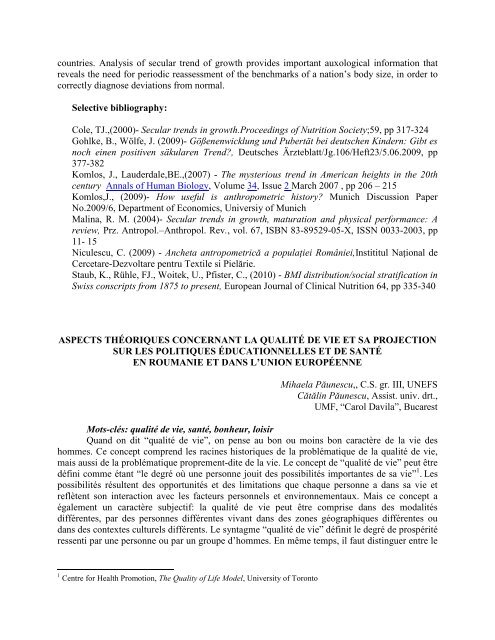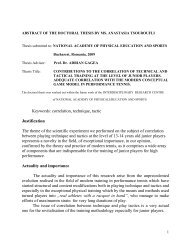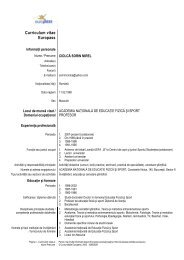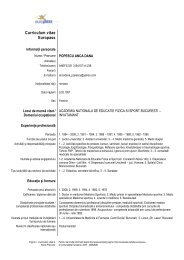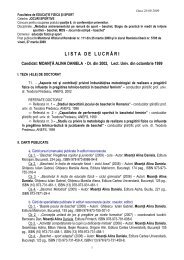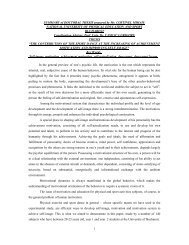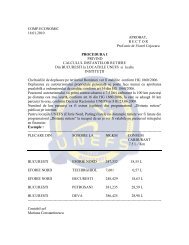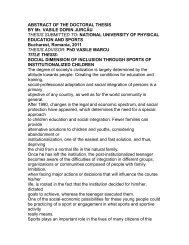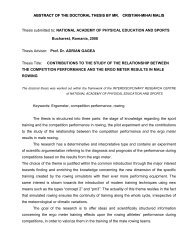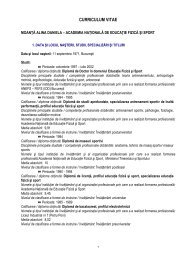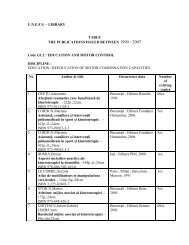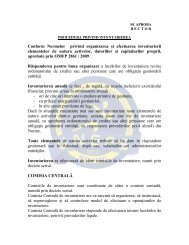GENERAL GUIDELINES FOR TRAINING DIET Conf. univ. dr - unefs
GENERAL GUIDELINES FOR TRAINING DIET Conf. univ. dr - unefs
GENERAL GUIDELINES FOR TRAINING DIET Conf. univ. dr - unefs
Create successful ePaper yourself
Turn your PDF publications into a flip-book with our unique Google optimized e-Paper software.
countries. Analysis of secular trend of growth provides important auxological information that<br />
reveals the need for periodic reassessment of the benchmarks of a nation’s body size, in order to<br />
correctly diagnose deviations from normal.<br />
Selective bibliography:<br />
Cole, TJ.,(2000)- Secular trends in growth.Proceedings of Nutrition Society;59, pp 317-324<br />
Gohlke, B., Wölfe, J. (2009)- Gößenenwicklung und Pubertät bei deutschen Kindern: Gibt es<br />
noch einen positiven säkularen Trend?, Deutsches Ärzteblatt/Jg.106/Heft23/5.06.2009, pp<br />
377-382<br />
Komlos, J., Lauderdale,BE.,(2007) - The mysterious trend in American heights in the 20th<br />
century Annals of Human Biology, Volume 34, Issue 2 March 2007 , pp 206 – 215<br />
Komlos,J., (2009)- How useful is anthropometric history? Munich Discussion Paper<br />
No.2009/6, Department of Economics, Universiy of Munich<br />
Malina, R. M. (2004)- Secular trends in growth, maturation and physical performance: A<br />
review, Prz. Antropol.–Anthropol. Rev., vol. 67, ISBN 83-89529-05-X, ISSN 0033-2003, pp<br />
11- 15<br />
Niculescu, C. (2009) - Ancheta antropometrică a populaţiei României,Instititul Naţional de<br />
Cercetare-Dezvoltare pentru Textile si Pielărie.<br />
Staub, K., Rühle, FJ., Woitek, U., Pfister, C., (2010) - BMI distribution/social stratification in<br />
Swiss conscripts from 1875 to present, European Journal of Clinical Nutrition 64, pp 335-340<br />
ASPECTS THÉORIQUES CONCERNANT LA QUALITÉ DE VIE ET SA PROJECTION<br />
SUR LES POLITIQUES ÉDUCATIONNELLES ET DE SANTÉ<br />
EN ROUMANIE ET DANS L’UNION EUROPÉENNE<br />
Mihaela Păunescu,, C.S. gr. III, UNEFS<br />
Cătălin Păunescu, Assist. <strong>univ</strong>. <strong>dr</strong>t.,<br />
UMF, “Carol Davila”, Bucarest<br />
Mots-clés: qualité de vie, santé, bonheur, loisir<br />
Quand on dit “qualité de vie”, on pense au bon ou moins bon caractère de la vie des<br />
hommes. Ce concept comprend les racines historiques de la problématique de la qualité de vie,<br />
mais aussi de la problématique proprement-dite de la vie. Le concept de “qualité de vie” peut être<br />
défini comme étant “le degré où une personne jouit des possibilités importantes de sa vie” 1 . Les<br />
possibilités résultent des opportunités et des limitations que chaque personne a dans sa vie et<br />
reflètent son interaction avec les facteurs personnels et environnementaux. Mais ce concept a<br />
également un caractère subjectif: la qualité de vie peut être comprise dans des modalités<br />
différentes, par des personnes différentes vivant dans des zones géographiques différentes ou<br />
dans des contextes culturels différents. Le syntagme “qualité de vie” définit le degré de prospérité<br />
ressenti par une personne ou par un groupe d’hommes. En même temps, il faut distinguer entre le<br />
1 Centre for Health Promotion, The Quality of Life Model, University of Toronto


